Most bandoneons are between sixty five and one hondred and twenty years old. Most part of the instrument are made of wood, leather, cardboard, paper and bone glue; materials that are subject to droughth, wear and tear, and insect damage.bugs.
The good news is that most damages can be repaired.
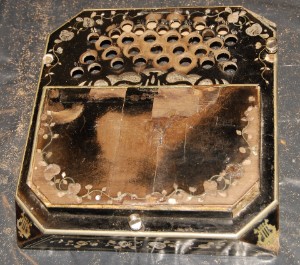
In my repair and restoration work I use the original materials and repair techniques as much as possible. All work to be done will be discussed with the player in advance; the agreed-upon work and a price will be confirmed in writing. Repairs can be divided in to three categories: air loss, mechanics and appearance. Below is a brief discription of the most common repairs. AIR LOSS
Sound board Bellows Bellows air valve Sealing leather Shutters | MECHANICS
Buttons Shutters Axels Springs
| APPEARANCE
Construction Veneer finish Inlay Varnish and polish
|
AIR LOSS For loss of air there are roughly four causes: one or more (sometimes minuscule) cracks in the sound board; leaks in the bellows and/or air valve; leaks at the leather seal of the heads; or the key shutters themselves leak. 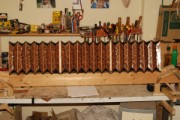
The bellows consists of over five hundred individual pieces that are for the most part glued together with bone glue. Due to for example droughth or wear small cracks can develope into leaks. Many bellows can be overhauled. Often it is possible to replace original bellows tape or repair the leather corners. If a bellows is too badly damaged or has been poorly repaired a new bellows is certainly an option; in some cases a new bellows can even be made using the original ground materials. The choice of material, dimensions and colours will be determined together with the player.
The bellows air valve is built in into the bellows frame and is hinged and sealed with leather. When the leather dries out or is damaged it must be replaced.
The heads of the bandoneon are attached to the bellows with thumb screws. Here again, the sealing material is leather. When damaged or dried out, it too must be replaced.
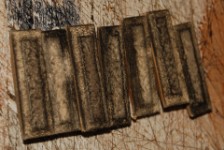
| Another common cause for air loss leaking air seals on the individual shutters. The shutters are covered with a special type of leather which, when hardened, will lose its functionality and will not close off the sound board properly. In that case the leather seal must be replaced. |
MECHANICS 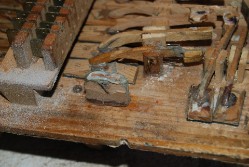
In many bandoneons the mechanics have become irregular or unstable.In my workshop I clean the mechanics and reajust them. The axels are stablilized and the springs adjusted so that a light and even touch is achieved. The shutters will be refurbished with special leather to make them air tight again. Often the small oval hinge leather between shutter and lever must be replaced. 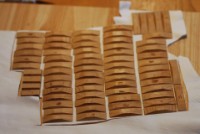
Sometimes buttons get stuck or feel very irregular. Often they are broken or dirty.
The buttons will be cleaned and, if necessary, refurbished with mother of pearl. In cases where buttons are beyond repair they can be replaced either with original buttons from a donor instrument or with identical, newly made buttons from my own workshop. 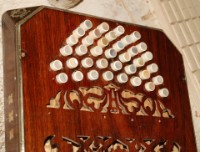
APPEARANCE Even bandoneons that are mechanicaly good and decently tuned may still show many a battle scar. Often the laquer is damaged and has deteriorated over time, the wood and/or structure has been damaged or broken. Often some crude repairs have been made to make the instrument playable in the quickest way possible. Some instruments are extremely dirty or have been sprayed over with synthetical paint. In my workshop I restore the wooden structure and veneer with the original materials so that the instrument’s appearance lives up to its original elegance. Rosewood veneer will be restored, varnish reapplied and buffed. German silver corners and lyra-inlays will be replaced where necessary, missing mother of pearl inlay will be restored. The aim is not so much to make the instrument look ‘new’ but to let a beautiful old instrument come into its full glory. | 
